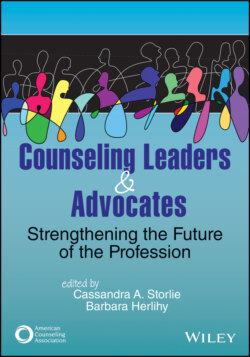Читать книгу Counseling Leaders and Advocates - Группа авторов - Страница 47
Practical Strategies for Invoking Change
ОглавлениеHaving discussed the “why” of leadership and advocacy, we now turn to an understanding of the “how.” That is, how do counselors engage in client and professional advocacy? And how does this differ across the various settings in which they serve? It can be daunting to consider the steps necessary to invoke change, particularly in school, community, and legislative arenas. This is often where leadership and advocacy intersect, where organization meets inspiration, and where many individuals feel ill-equipped to meet the challenge. We offer a model of counselor advocacy commonly used across specialty areas and settings, and we share some examples.
One of the earliest models of advocacy was proposed by Karen Eriksen (1997), who developed a seven-stage model to advocate for professional counselors through legislation, rulemaking, and the courts. Trusty and Brown (2005) adapted Eriksen’s model for school counselors, applying it to student and professional advocacy required in K–12 settings. Subsequently, Lawson et al. (2017) identified how Trusty and Brown’s model was the basis for counseling advocacy to change licensure laws in Ohio, North Carolina, and Virginia. Trusty and Brown’s model is foundational as an advocacy model for school and mental health counseling leaders, useful for professional and student/client advocacy, and commonly cited in the counseling literature (Chang, 2012; Sweeney, 2012). We describe each stage of the model, keeping in mind counseling specialty areas (e.g., school, clinical mental health, clinical rehabilitation) and types of advocacy (i.e., professional and student/client).
1 Develop advocacy dispositions. To begin, counselors understand how they are motivated to advocate for their students/clients and the profession, attending to their professional identity while determining their roles with other professionals and with those whom they serve.
2 Develop advocacy relationships and advocacy knowledge. In this stage, counselors not only build their networks but also pursue understanding about the people and systems they are seeking to affect.
3 Define the advocacy problem. In the third step, counselors gather data through needs assessments and other sources, defining both the problem and its roots. This occurs after connecting with others, which suggests that decision-making is not accomplished by one person alone.
4 Develop action plans. Trusty and Brown (2005) suggest that these plans be clear, but flexible, unless “an important moral principle is at stake” (p. 264). Eriksen’s (1997) model for legislative advocacy assumed that training others was an essential part of planning, but some forms of advocacy may not require such actions.
5 Implement action plans. Once leaders have implemented the plan, they need to collaborate with other stakeholders to monitor progress, address setbacks, and determine together when advocacy goals have been achieved.
6 Make an evaluation. To assess the impact, evaluation is critical. Evaluation criteria and planning must be considered earlier during the advocacy problem definition process (Stage 3) as well.
7 Celebrate or regroup. When successful, leaders call for celebration; when not, they call stakeholders to regroup and support one another, considering alternatives for new advocacy efforts.
Although other models are worthy of consideration, this model includes the essential elements of both one’s professional disposition toward advocacy and the organizational, data-driven steps to help leaders prepare for action across multiple settings. As we continue to explore advocacy opportunities in the sections that follow, consider how you might use this model to affect larger organizational and systemwide changes, but also consider the individual, everyday advocacy you might use to serve others.
